 The king is coming! But whose tavern will host the most auspicious feast to be held in his honor? Send your minions out to collect rare ingredients, prepare mouth watering recipes, and hire fearsome heroes to help defeat the pesky dragons that haunt the wilds! It’s time to prove your tavern is the only one worthy of a king’s patronage.
The king is coming! But whose tavern will host the most auspicious feast to be held in his honor? Send your minions out to collect rare ingredients, prepare mouth watering recipes, and hire fearsome heroes to help defeat the pesky dragons that haunt the wilds! It’s time to prove your tavern is the only one worthy of a king’s patronage.
Taverns & Dragons is a dice placement game of cunning and cooking for 2-5 players.
Gameplay Overview:
In a game of Taverns & Dragons, each player is given five action dice, three minions, and a tavern board in their chosen color. At the start of each round players will simultaneously roll all of their action dice and then take turns assigning these dice to spaces on the main board or their personal tavern board, in order to take actions.
The actions are: earn gold coins, get energy gems equal to the value of your die face, activate a minion, or cook a recipe. In addition to these actions, you may also buy heroes that give you special abilities, activate location abilities, and, possibly, fight a dragon.
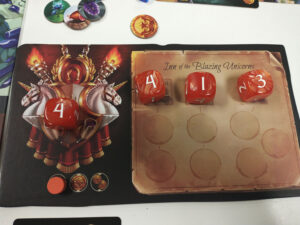
The main crux of the game lies in minion activation. To activate a minion, place a die on that minion’s space on your tavern board, then move its meeple that many spaces along the path on the main board. Your minion may collect one ingredient from either its starting or ending location. This ingredient is placed on your tavern board in the corresponding minion’s backpack. Ingredients may be moved from your minion’s backpack to your pantry (thus making them available for use in recipes later) only when the minion makes it back to the starting town space. You may also pay to use special locations adjacent to your minion.
Once every player have used all five of their dice the current round ends. Depending on which round it is, certain features will activate, and a new round begins with players once again rolling all action dice.
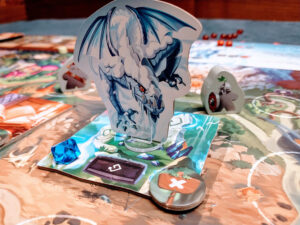
Points will come largely from cooking recipes. In order to prepare a recipe a player must have the ingredients corresponding to one of the available recipe cards—during the first round there is just one, but more are revealed later—in their pantry. An action die is assigned to complete the recipe and the player will receive points equal to the value of that die, plus the value listed on the recipe card and possibly a bonus depending on which space the recipe card was on.
Didn’t you say there were dragons? Yes, I did. In round 2 and again in round 5 a random dragon will appear to terrorize one location on the board! Minions who begin or end their activation adjacent to a dragon may fight it. To do so, a player must spend energy gems in order to roll 1-3 hunting dice (they roll one die per gem spent). These dice can either damage the dragon, and possibly give you some tasty meat or victory points, or cause the dragon to attack your minion in return!
Play will continue with players using their dice to take actions until the end of the seventh round, at which point the player with the most points wins.
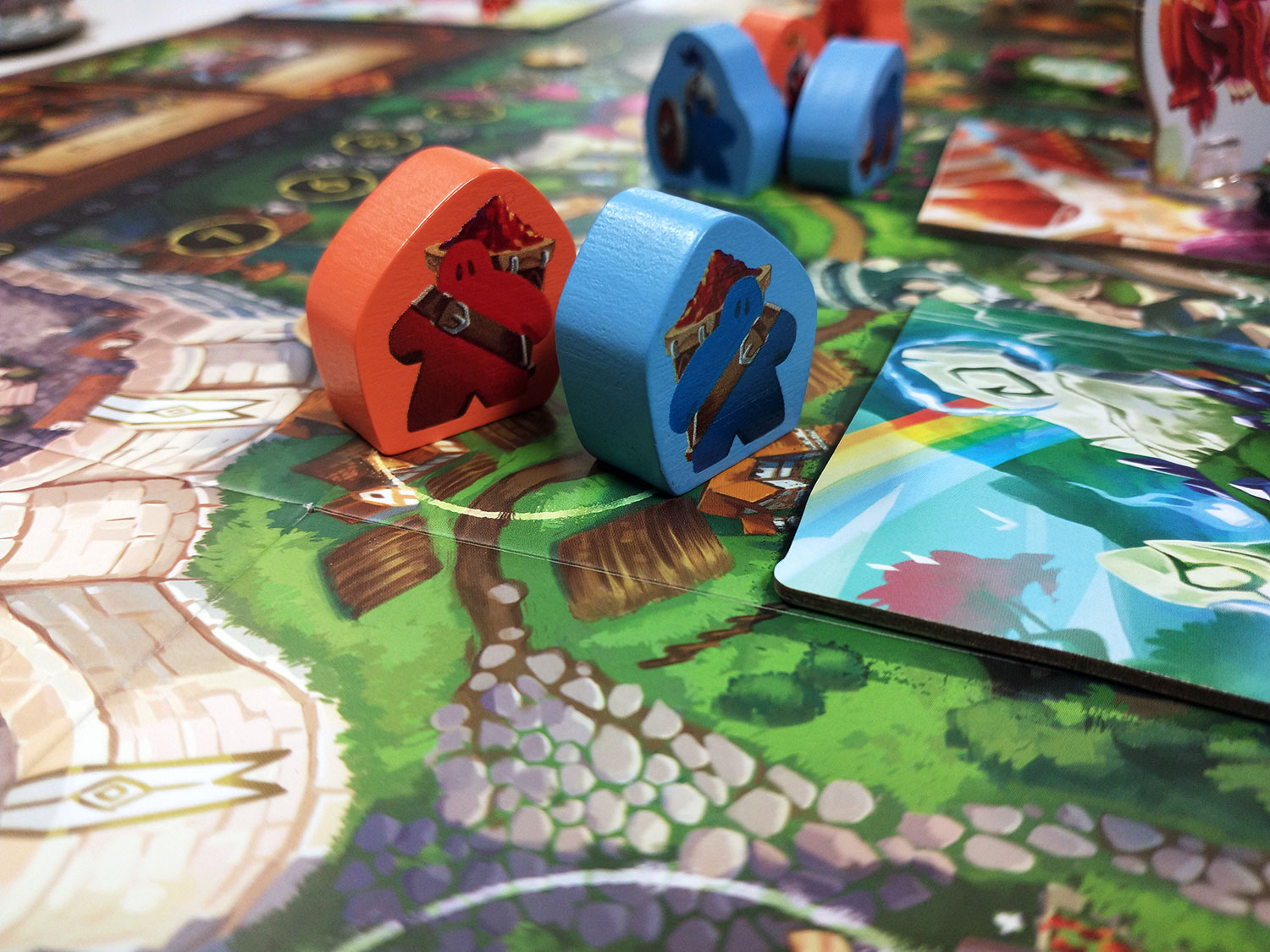
Gameplay Experience:
Deciding how to use your dice is a big key to success with this game. Deciding which minion to move, which ingredients to collect, when to use special abilities from locations or heroes you’ve acquired, all adds to the tension. All the while, you’ve got your eyes on those recipes! You really can’t ignore recipes, as they are a main source of points, so you’re constantly worried your opponents might snatch one up that you’ve had your eye on. But once a recipe is cooked a new one is drawn to replace it, so there will always be another chance. The game itself is like a stew of various ingredients that nicely compliment each other. There’s a healthy amount of dice chucking, with a heaping spoonful of worker activation and a dash of press-your-luck.
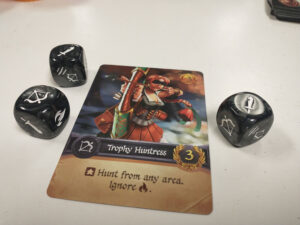
The game shines best with the “modules” which are really just a few additional rules, easily implemented. These add end-game objectives in the form of “Secret Missions”, unique tavern abilities, and events that will trigger at the start of certain rounds. While these are called modules, I really think they should just be included in the main rules with a suggestion in the rulebook for an easy mode where you leave them out. I don’t think anyone who plays regularly will opt out of using at least one or two of these so-called modules (I recommend at least using the secret missions).
The special locations you can visit during the game will be randomly set up at the start, though there is a suggested setup for your first game and these make for interesting strategic decisions that will differ from game to game. The available heroes and recipes will also help shape your strategy. This nice amount of variability makes the game highly replayable.
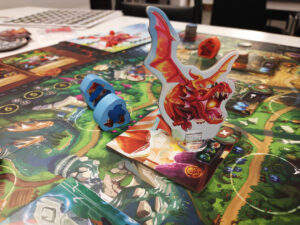
I didn’t find the dragons particularly exciting or rewarding to fight. Compared to the recipes, their point yield just isn’t very high. They are, however, sometimes your only source of meat, which some recipes require. Think of them as more of an annoyance than what this game is actually about. The game is about running a tavern and cooking tasty stuffed dragon eggs with mushrooms, served on crispy bread sticks! That’s not necessarily a downside, except that “dragons” is as much a part of the title as “taverns”.
The other matter is that of game length: the box says one hour, which I find highly optimistic. Two decisive players who know the game well can play it in an hour, but with more players it’s going to take longer, especially at first. I’d say two hours is a safer call, and that’s probably being generous. But then again, you’re not really bored during that time as the game has lots to offer. There is also some luck, though there are ways to reroll dice. That’s where preparing for possible bad luck comes into play—you need to have a few heroes on your side to help out, and stockpile some reroll tokens. I don’t consider a little luck a bad thing, but particularly unlucky rolls may prove frustrating. There were also a few quirks about the rules I found confusing, and the box insert could have been better.
Final Thoughts:
Taverns and Dragons is a fun game that has a lot going on without being overly cumbersome. Once you understand the flow of the game, things run pretty smoothly. Turns are typically quick, though there will be times you might slow a little while analyzing your options. Despite the game length running longer than advertised, the game doesn’t feel like it lasts longer than it should, and it’s satisfying when you manage to pull off one last recipe right at the end.
The artwork is fun and lighthearted and there are many little touches that add to the amusement of the game—even if the meeples that aren’t really meeples are kind of weird. I do wish the dragons were a little more exciting and some things could have been clearer in the rules and on the cards. Luck does play a part in the game, but there are ways to at least mitigate some of it. Overall, I’m impressed with this design.
Final Score: 4 Stars – Like a souffle with magma sauce, this game is hot, but tasty!
 Hits:
Hits:
• Variability
• Competitive and engaging
• Turns are typically quick
Misses:
• Lasts longer than stated
• Some rules could be clearer
• Dragons aren’t very exciting





















